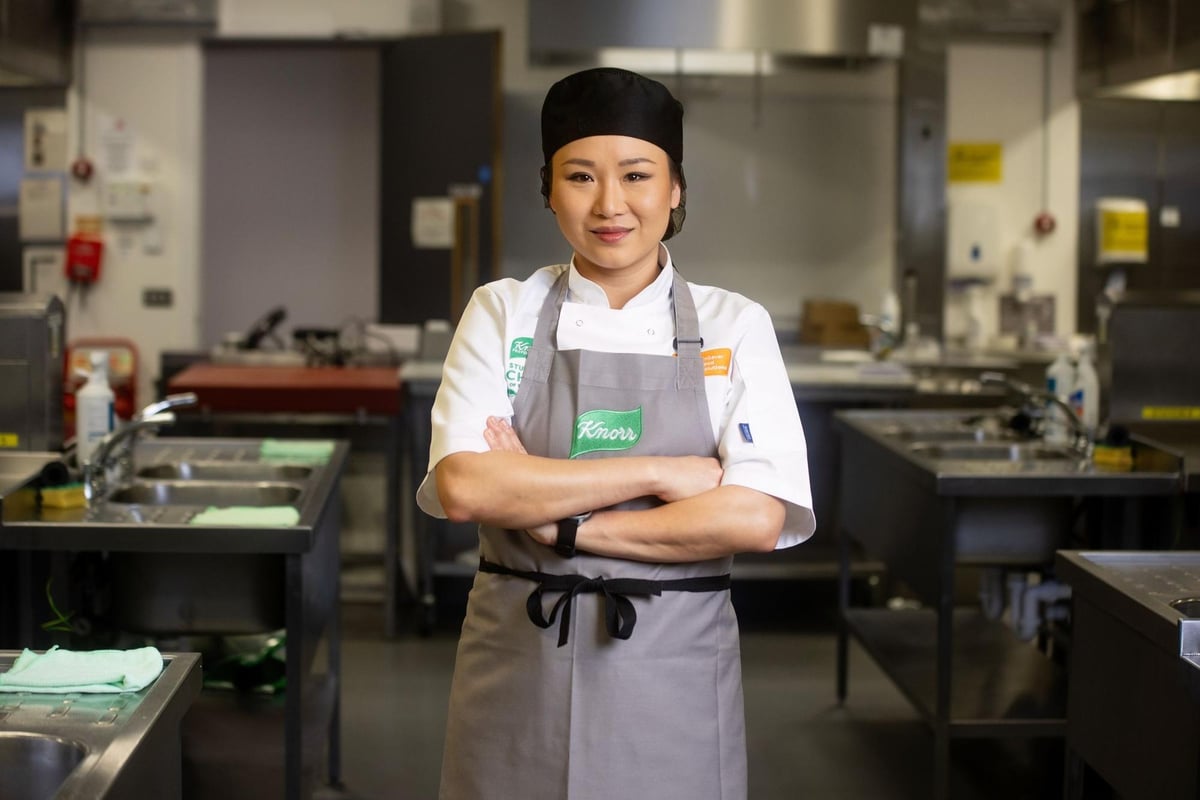/cdn.vox-cdn.com/uploads/chorus_image/image/73977192/DSC08906.0.jpg)
Chef Tian Yong preparing beltfish wrapped in pancakes at Bistro Na’s How chef Tian Yong prepares imperial court cuisine in San Gabriel Valley’s most ambitious restaurant Bistro Na’s has been a standard-bearing Chinese fine dining restaurant in Los Angeles since it opened in 2016. Tucked inside a Temple City strip mall, the opulent restaurant brings imperial Manchu cuisine rooted in the Qing dynasty’s (1644 to 1912) royal courts to Southern California. For years, Bistro Na’s was the Los Angeles area’s only Michelin-starred Chinese restaurant until December 2022, when it lost its star.
That hasn’t slowed down the restaurant or its head chef, Tian Yong, who introduced one of the best Beijing duck preparations in Los Angeles, one that requires a minimum one-week reservation, and sometimes longer. In addition, Tian has been busy with a seasonal menu that changes every three months. A Beijing native with more than 24 years of culinary experience, Tian previously worked at the renowned Grand Mansion Restaurant and cooked for luminaries during the 2008 Summer Olympics.

The chef oversees much of the ingredient selection so that they remain faithful to imperial cooking techniques while allowing for some modernization along the way. Chef Tian Yong. Bistro Na’s newest spring menu features 16 additions, reaffirming its place as a fine dining destination.
Highlights include the Beijing duck and king crab served four ways: steamed, deep-fried, infused with steamed egg, and paired with noodles. Other offerings include crispy shrimp with salted egg yolk and Emperor’s Jar Soup, a luxurious medley of beef tendon, mushrooms, fish maw, quail eggs, and sea cucumber.While no longer exclusive to the imperial court, these dishes remain a symbol of refinement.
With this latest spring menu, Bistro Na’s continues to make the case for being one of the best Chinese fine dining restaurants in the country.Na’s Roast Duck (北京烧鸭)Before Peking duck became internationally recognized, Beijing roast duck had long been a featured dish of imperial cuisine, dating back to the Ming (1368 to 1644) and Yuan (1271 to 1368) dynasties. Historically, ducks were marinated and stored in deep, dry wells for several days before roasting.
These wells provided ventilation, lowering moisture while allowing the skin to crisp. “This method is similar to modern dry-aging,” says Tian.Imperial chefs continually refined cooking techniques to meet the royal family’s high culinary standards, and Beijing roast duck was one of their signature dishes.
Though closely related, Beijing roast duck and Peking duck have distinct differences. The modern version of Peking duck is known for its ultra-crispy skin and precise slicing. Beijing roast duck, however, was historically a luxury reserved for the emperor and high-ranking officials.
Only the best quality ducks were selected, meticulously prepared, and roasted to showcase its opulence.Unlike Peking duck, which is traditionally roasted in an open oven with direct flames, Beijing roast duck is cooked in a closed oven, where heat circulates evenly. This technique results in a slightly crisp but deeply flavorful skin and exceptionally tender, juicy meat.
The duck is carved into thicker slices that include both skin and meat, while Peking duck emphasizes crisp skin with minimal meat. Na’s roast duck. Crispy meatballs with black fungus and jalapeñosJiāo liū wánzi, or crispy meatballs with black fungus and jalapeños, is a Beijing dish featuring deep-fried meatballs coated in a glossy, sweet-savory sauce.
Thought to have originated in the imperial kitchens of the Qing dynasty, it was a refined variation of traditional braised meatballs. At Bistro Na’s, Tian updates the dish by adding jalapeños for a modern kick while preserving its texture. The meatballs are fried until golden and crisp before being coated in a rich, well-balanced sauce that clings to the exterior without compromising the crunch.
The inclusion of black fungus adds an earthy element, while the jalapeños provide a subtle heat.During the Qing dynasty, Manchu rulers favored hearty, meat-based dishes with bold flavors and contrasting textures, making this dish a natural fit for imperial banquets. Today, it remains a testament to the techniques of palace cooking, where crispness, umami, and balance were key elements of its cuisine.
Jiāo liū wánzi, or crispy meatballs with black fungus and jalapeños. Triple onion spicy chicken with chile oilSān cōng bàn á là hóng yóu jī, or triple onion spicy chicken with chile oil, is a bold, aromatic dish with poached chicken dressed in a numbing red chile oil sauce. Employing three kinds of onions — scallions, leeks, and shallots — the dish balances heat with a fragrant depth of flavor.
During the Qing dynasty, Sichuanese flavors gained prominence in imperial court cuisine as emperors developed a preference for the region’s signature spiciness. The use of three types of onions was considered a distinct touch, as each added an aromatic note to the dish.At Bistro Na’s, Tian gently poaches the chicken until tender and juicy, then cools it in an ice bath to retain its texture.
The onions are either lightly sautéed or mixed raw to create a layered aroma before being combined with chile oil, Sichuan peppercorns, soy sauce, and vinegar, plus sugar and sesame oil for balance. The dish is assembled tableside for an elevated presentation. “Chicken represents prosperity and good fortune, while red oil signifies auspiciousness, making this a favored banquet dish,” Tian says.
“This is an adaptation of our existing red broth chicken, presented similarly to the Yusheng Lohei style popular in Guangdong. It allows us to maintain the dish’s unique flavors while adding an interactive element.” Sān cōng bàn á là hóng yóu jī, or triple onion spicy chicken with chile oil.
Steamed pork with preserved mustard greensA staple of Jiangnan cuisine, steamed pork with preserved mustard greens was supposedly served at the Qing imperial palace. Preserved mustard greens were valued during this era for their umami-rich, fermented flavor, and used frequently to enhance the flavor of meat.For the royal family, high-quality pork belly ensured a balance of lean and fat with a tender texture.
Unlike modern versions, which are often served over rice, the imperial preparation may have been accompanied by delicate steamed buns. A slow steaming process allowed the pork to develop its signature melt-in-your-mouth softness, an important aspect of imperial cooking.At Bistro Na’s, Tian reinterprets this classic dish with minced Kurobuta pork, which he blends with stir-fried preserved mustard greens.
“Since I designed this as a rice accompaniment, I added some jalapeño for balance,” he says. The dish is served alongside handmade pumpkin cake. Steamed pork with preserved mustard greens.
Deep-fried eggplant (烹汁脆皮茄子)A dish rooted in Qing Dynasty imperial cuisine, deep-fried eggplant, or pēng zhī cuì pí qiézi (烹汁脆皮茄子), transforms a humble ingredient into a banquet-worthy delicacy. Imperial chefs, known for elevating everyday foods, developed a technique that preserved the eggplant’s crispiness. Unlike traditional stewed eggplant, this version is lightly battered and deep-fried to achieve a golden, crispy exterior and a soft, creamy interior.
It’s then coated in a palace-style sauce with seasonal ingredients, such as watermelon seeds, sunflower seeds, sesame seeds, raisins, dried olives, and hawthorn. In the summer, he might substitute pine nuts and dried apricots.Manchu rulers favored dishes with contrasting textures, making this a natural fit for royal feasts.
Precise frying ensures the eggplant remains crisp while absorbing the sauce. Pēng zhī cuì pí qiézi, or deep-fried eggplant. Beltfish wrapped in pancakes (带鱼卷饼)Dàiyú juǎnbǐng (带鱼卷饼) is a Qing Dynasty-inspired dish featuring crispy or braised beltfish or ribbonfish wrapped in delicate pancakes.
Once a luxury item in imperial kitchens, beltfish was prized for its texture and mild sweetness. Court chefs refined its preparation to enhance its elegance while making its chewable small bones more manageable.Start by wrapping the fish in pancakes so eating them is less messy.
The fish also symbolizes abundance and prosperity, making it a banquet favorite. “I braise the fish for four hours until the bones become soft and edible. The meat stays crispy yet holds together well, perfect for wrapping with seasonal vegetables,” says Chef Tian.
Dàiyú juǎnbǐng, or beltfish wrapped in pancakes. Royal court pigeon noodles (宅门鸽子打卤)A dish rooted in Qing imperial cuisine, zhái mén gē zi dǎ lǔ (宅门鸽子打卤) features a savory, pigeon-based gravy served over noodles or rice. Pigeon, prized for its mild texture and nutritional benefits, was favored by the Manchu rulers, who had a strong hunting tradition that valued game meats.
“My version starts with a pigeon bone-based broth, smoked pigeon, and a housemade sauce of pork, shiitake mushrooms, daylily, wood ear mushrooms, and eggs, served with handmade noodles,” says Tian. “The broth-to-noodle ratio is one-to-one, creating a rich yet light consistency. The sauce isn’t overly salty, emphasizing freshness, and can be enjoyed as a soup on its own.
” Zhái mén gē zi dǎ lǔ, or royal court pigeon noodles. Beijing sweet fried pancake (北京糖油饼)Běijīng táng yóu bǐng (北京糖油饼) is a crispy, golden-brown fried pancake coated in a caramelized sugar glaze. Now a beloved Beijing street food, it traces its origins to imperial palace cuisine during the Ming and Qing dynasties, when fried pastries became a staple of court banquets.
Though commonly found in Beijing’s hutongs and breakfast stalls today, this preparation reflects the influence of imperial chefs, who specialized in delicate, crispy pastries to suit the royal palate. The pancake was often served at palace tea sessions, where fragrant teas balanced its sweetness and richness. In imperial China, foods made with oil and sugar symbolized prosperity and good fortune.
Sugar-glazed pastries were frequently presented as celebratory offerings during festivals, banquets, and royal birthdays. Běijīng táng yóu bǐng, or Beijing sweet fried pancake. Close-up of a Beijing sweet fried pancake.
Bistro Na’s is located at 9055 Las Tunas Drive, Suite 105, Temple City, CA 91780..















